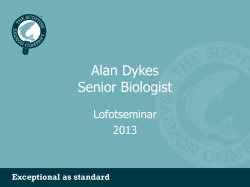
Investigate how salinity impacts the distribution of estuarine fish in
Where in the Bay? By: Pat Harcourt and Liz Duff http://pie-lter.ecosystems.mbl.edu/content/striped-bass-curriculum lduff@massaudubon.org Plum Island Ecosystem Long Term Ecological Research (PIE-LTER) Description: Using provided salinity data and salinity maps, students will interpret data to discover the distribution of fish species in the Chesapeake Bay. Essential Questions: Do salinity levels impact fish distribution in an estuary? How does salinity in an estuary change seasonally? Grade Level(s): Grade 5-12 Time/Duration: Class 1 (45 minutes to 1 hour.) Reflection can be done as homework. Initial preparation time to print and laminate the sheets might take one hour. Purchase/accumulate tokens, another hour. Once that is done, there is little prep involved. Subject: Ecology, Marine Biology, Physical Science, Life Science, Earth Systems Next Generation Science Standards: 5-ESS2-1. Develop a model using an example to describe ways the geosphere, biosphere, hydrosphere, and/or atmosphere interact. MS-LS2-4. Construct an argument supported by empirical evidence that changes to physical or biological components of an ecosystem affect populations. HS-LS2-2. Use mathematical representations to support and revise explanations based on evidence about factors affecting biodiversity and populations in ecosystems of different scales. Correlating Ocean Literacy Standards 5. The ocean supports a great diversity of life and ecosystems. d. Ocean biology provides many unique examples of life cycles, adaptations and important relationships among organisms (such as symbiosis, predator-prey dynamics and energy transfer) that do not occur on land. f. Ocean ecosystems are defined by environmental factors and the community of organisms living there. Ocean life is not evenly distributed through time or space due to differences in abiotic factors such as oxygen, salinity, temperature, pH, light, nutrients, pressure, substrate, and circulation. A few regions of the ocean support the most abundant life on Earth, while most of the ocean does not support much life. Target Learning Objective(s)/Concept(s)/ Desired Results: 1. Salinity impacts the distribution of adult fish in an ecosystem. 2. Different fish species are tolerant of different levels of salinity. 3. Students will be able to correctly differentiate between low and high salinity levels. 4. Students will be able to understand the color code on the salinity map, and correctly place tokens representing fish species in the regions the fish species can survive. 5. Students will observe that salinity affects the distribution of some fish species. 6. Students will observe that salinity levels vary seasonally, and will conclude that fish distribution will vary seasonally. Skills: 1. Process Skills: Observing, Raise questions, formulate hypotheses. 2. Critical Thinking Skills: Applying, Expressing ideas. 3. Scientific Reasoning Skills: Searching for data and its meaning. Prior Knowledge: Establish that students know the following 1. Salinity is a measure of how salty the water is. 2. The saltiness of the water is different in different places, and can change in a single place due to tides, rain, storms, and evaporation. 3. Many marine animals are specialized to live most comfortably in a certain level of saltiness. 4. Some marine animals can swim or crawl, and they may move to stay in the most comfortable conditions. Technology to complete lesson: Multimedia Projector, Internet Access, or Download Where in the Bay PowerPoint in advance. http://pie-lter.ecosystems.mbl.edu/content/striped-bass-curriculum Essential Questions: Do salinity levels impact fish distribution in an estuary? How does salinity in an estuary change seasonally? Introduction/Background Information: Salinity: Salinity is a measure of how salty the water is. It is one of the abiotic (non-living) factors impacting the distribution of life. The saltiness of the water is different in different places, and can change in a single place due to tides, rain, storms, and evaporation. Fresh water is less dense than salt water, and may form a lens floating on top of salt water, in an estuary, where fresh water is flowing to the sea, and salt water flows in with the tide. Thus surface water may have lower salinity than deeper water. Storms not only provide additional fresh water through precipitation, reducing salinity levels, but also can mix surface water with deeper water through the impact of wind and waves. Many marine animals are specialized to live most comfortably in a certain level of saltiness. Some marine animals can swim or crawl, and they may move to stay in the most comfortable conditions. Where is the Chesapeake the freshest (lowest salinity)? Where is salinity highest? How does salt water get so far into the Chesapeake Bay? The Chesapeake Bay is freshest in the tips of the drainage rivers. It is saltiest closest to the ocean. Tidal movement helps to distribute the salt. Why does salinity changes seasonally? Salinity levels change with seasonally because the amount of fresh water brought by the rivers changes seasonally. There tends to be more fresh water transported in the spring because the snow on the land is melting feeding the rivers. This leads to a lower salinity. As greater evaporation occurs in the summer and fall, the areas with higher salinity expand. Striped Bass: Striped bass are a popular fish with an interesting lifestyle. They spawn in few areas in the Atlantic, primarily in Chesapeake Bay, Delaware Bay and the Hudson River. They are anadromous fish, laying their eggs in fresh water but living in water with a wide range of salinities during their juvenile and adult life. Striped bass migrate in the summer months to points north as far away as the points within the Gulf of Maine. Some take up residence in the Plum Island Sound Estuary in Massachusetts for the summer months, while others pass through, heading to points further North. Scientists are investigating: Why do they travel so far? Striped bass are commercially harvested in some southern states, and are eagerly sought by sport-fishermen in Massachusetts. Populations of striped bass declined markedly in the 1980s and their populations have increased thanks to conservation efforts. Where in the Bay is an introductory lesson focuses on a number of different fish species, and compares their tolerance to different salinity (salt content) levels. This lesson is a part of the Striper Science curriculum. Striper Science is a set of lesson plans and resources for upper elementary through high school level based on striped bass research conducted in Massachusetts. Resources include PowerPoint presentations, inquiry lessons based on databases, field studies, and online videos. We are proud to present these lesson plans and resources which are based on Next Generation Learning Standards. Additional lessons in the curriculum focus further specifically on Striped Bass. This work was conducted by partners involve in the Plum Island Sound Long Term Ecological Research (PIE-LTER). The scientific research was conducted by Massachusetts Cooperative Fish and Wildlife Research Unit, UMass-Amherst (Dr. Martha Mather, Sarah Pautzke and Kristen Ferry) and supported by the Massachusetts Division of Marine Fisheries. Lesson developers and advisors include Liz Duff, Martha Mather, Kristen Ferry, Robert Muth, Jack Finn, Sarah Pautzke, Pat Harcourt and Melissa Sanderson. Striper Science was funded by the National Science Foundation. Learn about research on striped bass traveling choices and diet done by Kristen Ferry and Martha Mather in Plum Island Sound. Lesson Plan (PDF) Why Stripers Go, Part 1 (8 minutes) Why Stripers Go, Part 2 (10 minutes)> Learn about striped bass behavior in Plum Island Sound based on research done by Martha Mather and Sarah Pautzke. Bass Habitat Use Lesson Outline (PDF) Bass Habitat Use Part 1 (9.5 minutes) Bass Habitat Use Part 2 (7.5 minutes) Guidelines/Procedures: Preparation: 1. Print out the salinity maps (page 9 & 10) in color and laminate them. Make sure you have enough for 1 per team. (10-12?) 2. Print out the “Salinity Survival” tables (page 8) for teams to fill out. (This can be done as a whole class.) 3. Find tokens, or make copies of slide 11 for students to cut up. 4. Review the PowerPoint Facilitation Guidelines: 1. Discuss with students whether any of them have gone fishing before, and where they go to find fish. Do they like fishing in saltwater or fresh water. Do they find the same or different fish in those locations? 2. Introduce the activity via the slide show. PowerPoint 3. Fill out individually, or as a class the “Salinity Survival table”. Check answers and discuss before proceeding. 4. Pass out the maps and tokens and have students place on the Chesapeake Bay map the location of the different fish species. 5. Review the following instructions with the students. Instructions: 1. Give Explanation: Many fish cannot live where it is too fresh or too salty. Some parts of the Chesapeake Bay are very salty (high salinity) others are nearly fresh (low salinity). In this activity you will be placing a fish in parts of the bay with the right salinity for their survival. 2. Look at the table showing different kinds of fish and the salinity of the water they can live in. Salinity is given in parts per thousand (ppt). On some charts and graphs this is written 0/00. The salinity of the Chesapeake Bay ranges from near 0 to 30 ppt. Divide the fish in the table into three groups: those that can live in High, Low, and Both High and Low. Write each fish’s group on the line. 3. Choose tokens, or create a token or symbol to represent different fish species. For example, paper clips might represent low salinity fish. Or yellow play-dough could be used to make a yellow perch. Using the spring salinity map, decide where to place the fish on your map of the Bay. For fish that can live in both high and low salinity, use tokens of the same color in different areas of the Bay. You can cut up the fish on page 12 of this document for tokens. 4. Optional: If you are using play dough or other tokens, Make a key showing what fish is represented by each token/symbol. 5. Look at the summer and fall salinity maps and move the fish if necessary. What fish had to be moved? How far did they move? 6. Discuss: If you were going fishing, how would the salinity of the water affect your plans? 7. Reflect: Have students write in their science journal reflections about this activity. Suggested writing prompt: Write about three things they learned, two questions they have and one comment. High School Level: Based on what you know about salinity, what suggestions do you have to maintain biodiversity in the Chesapeake Bay? Please Explain your answer. Discussion: Which fish are most impacted by salinity levels? How does the seasonal variability in salinity affect species of fish? If you were going fishing, how would the salinity of the water affect your plans? High salinity fish expand their range in the summer and fall. This includes bluefish, needlefish, and sea horse. Low salinity fish reduces their range in the summer and fall. This includes brown bullhead, white catfish, and yellow perch.Fish that are adapted to high and low remain the same: American eel, sheepshead minnow, and striped bass. It depends on what kind of fish you want to catch where you would want to go fishing. Materials: 1. 2. 3. 4. Slideshow “Where in the Bay” Introduction Slideshow Projector and Pointer Chesapeake Bay Salinity Survival Table. 1 per team of 2-3 students. (end of this document) Chesapeake Bay Salinity Maps. Give a copy of the Spring version, and then the one showing seasonal comparicons. It may be helpful if these are laminated. 1 or each map per team of 2-3 students. (end of this document) 5. Tokens to represent fish. This could be a copy of page 10 of this document for each team to cut up and scissors (end of this document), or play dough of different colors, post it notes, paper, different colored cereal etc. Post it notes will allow you to move things around and hold it up to show others. Play dough is fun to form into fish shapes. References: Salinity tolerances in Chesapeake Bay are found on the Estuarine Living Marine Resources (ELMR ) database. http://ccma.nos.noaa.gov/ecosystems/estuaries/elmr.aspx GIS Data Courtesy of Paula Jasinski, NOAA Chesapeake Office Extensions: Investigate: Striper Prey and Salinity. Striped Bass can live in a wide range of salinity levels, but can their prey? Investigate: Where Striped Bass Spawn. Use ELMR database to search where Striped Bass spawn. Evidence of Understanding: Students will correctly fill in the Salinity Survival Table (Page 7 of this document). Students will correctly place fish species on the maps. Student s respond thoughtfully to the writing prompt with three things they learned, two questions they have and one comment. Resources: Recommended Reading Russell, Dick. Striper Wars: An American Fish Story Washington D.C.: Island Press- Shearwater Books 2005. Print. Glossary: Salinity: the concentration of mineral salts dissolved in water. Anadromous: Migrating up rivers from the sea to breed in fresh water. Used of fish. Distribution: The arrangement of items over a specified area. Estuary: The wide part of a river where it nears the sea; fresh and salt water mix. Fish migration: Movement of fish from one aquatic habitat to another. For example, anadromous fish move from estuarine and marine habitats to freshwater to breed. Fresh water: Water with a salinity less than .05 parts per thousand. Hypersaline: Water with salinity greater than 35 parts per thousand. (Super salinity) Juvenile: Fish from one year of age until sexual maturity. Mesohaline: Water with a salinity of 5 to 18 parts per thousand. (Medium salinity) Oligohaline: Water with salinity more than .05 and less than 5 parts per thousand. (Low salinity) Polyhaline: Water with salinity greater than 18 and up to 35 parts per thousand. (High Salinity) Predator: An animal that lives by killing and eating other animals. Prey: An animal hunted or caught for food. Parts per Thousand (ppt): A way of measuring salinity. If a sample has a salinity of 1 ppt, this means that it has one unit of salt per thousand units of water. Schoolies: Young striped bass, typically 3-5 years old. Spawn: To produce or deposit eggs. Teacher Version Salinity Survival Table for Chesapeake Bay, Maryland (See the PowerPoint for Mapping Answers) High and Low High Low High High High and Low High and Low Low Low Student Version Name ________________________ Date ____________ Salinity Survival Table for Chesapeake Bay, Maryland High and Low Spring Salinity Map Chesapeake Bay, Maryland Spring Salinity Map Seasonal Comparison Chesapeake Bay, Maryland
© Copyright 2025









